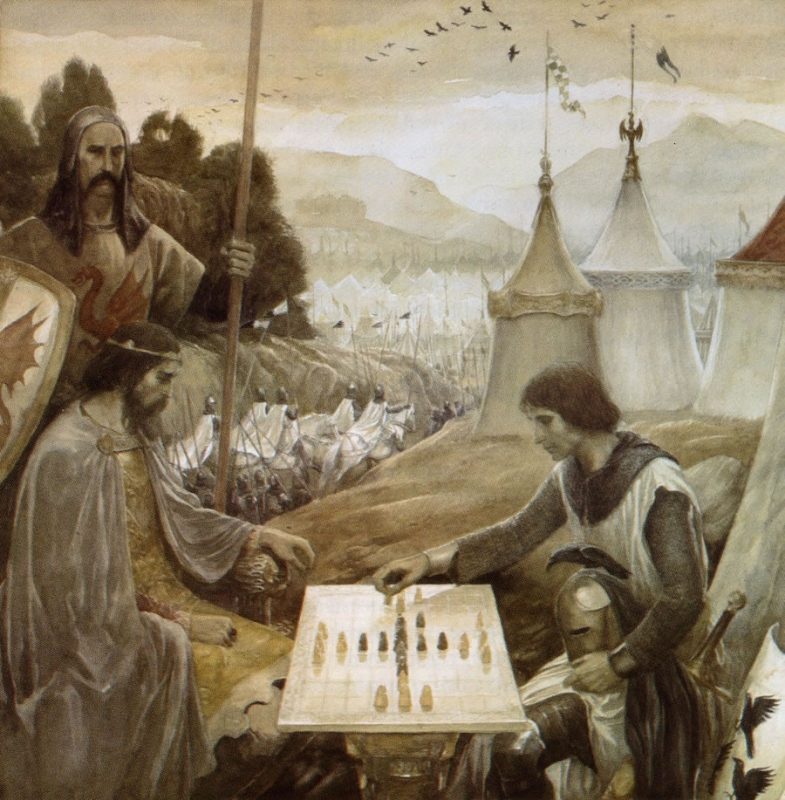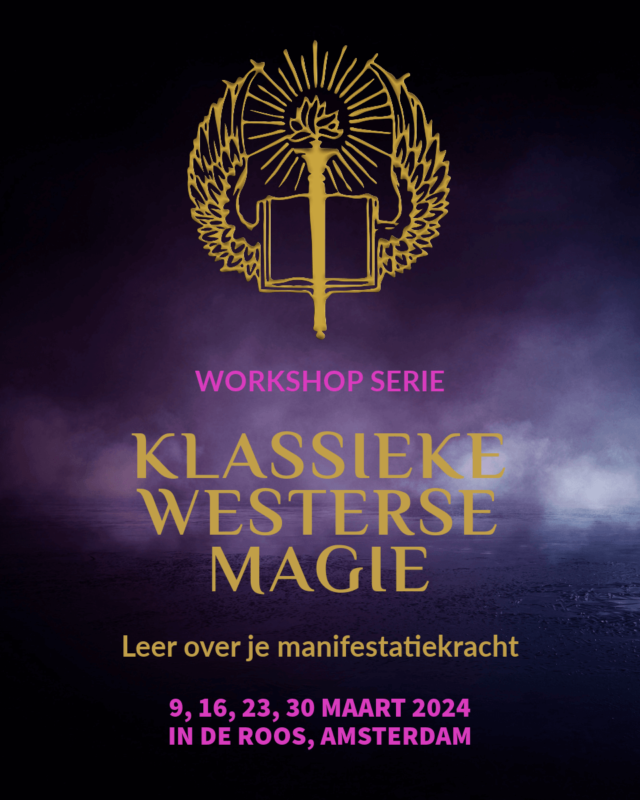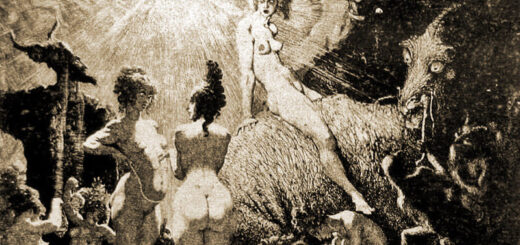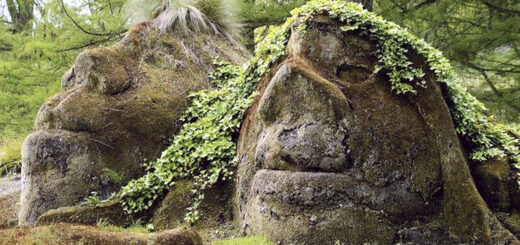Merlin’s Chess or the Magic of Avalon – Part 2
Within the adventures of Arthur, his ladies and knights of the Round Table and Merlin, there are often remarks, especially from the Welsh sagas, that the companions of the Table are in some kind of hazardous dispute with the inhabitants of the Otherworld. Preiddeu Annwn (Spoils of the Underworld) tells that Arthur enters this realm with an extraordinary band of hero-warriors.

On one of those chivalric missions, they are in search of a magical cauldron, that has the reputation to revive dead people. Besides, mysteriously, the fire under the cauldron has been “warmed by the breath of Nine Maidens”. The company of Arthur have to make their way through Seven levels into this Otherworld, known as: Caer Siddi, Caer Rigor, Caer Vandwy, Caer Pedryfan, Caer Gollud, and Caer Ochren of which the Annwn is the seventh level, the place or doorway where the world of men (earth) and the Otherworld meet. As they make it through the seven Caers (steps or places), succeeding in bringing the cauldron back, “except seven none returned”, they will never be the same. There is a price to pay to travel to such places. There are other tales known to report that people have returned for a day, while in the earth-realm several decades may have passed. The world of Faery and that of Arthur overlap at every point in the stories and poems.
All great heroes may seem like giants to the mortal that enters the Underworld, because they are mythic archetypes, drawn from the deepest depths of the human imagination. Faery and Arthur’s world are of a kinship as we can see in the search for the Grail and the wondrous tale where Arthur plays chess with his nephew Owein (Gawain) on a magical chessboard called Gwyddbwyll or Merlin’s Chess.
Merlin is the one who walks with the Ancients
It may be good to remind ourselves that Merlin, as prophet and Mage, has access into this realm of the Otherworld, by his virtue of being a breed of both worlds. He is of both and of none. This makes him loved and hated by inhabitants of both worlds that fear or envy him. Merlin is a chess player, but not to be confused with the earthly strategy game, rather with a teacher of a higher order of wisdom, who oversees the greater moves of “the heavens and the earth”. Merlin is the “one who walks with the Ancients”. This can be translated as the gods or the wandering planets, indicating that Merlin knew his astrophysics. Being a traveler in the world of men and faery (Shidde), Merlin’s knowledge of earthly astrology intermingled with that of faery astrophysics. Often it is said that faery knows much more of “Star-lore” then mankind will ever know. Tradition and experience has told us that they are derived from starlight and made out of the brightness and beauty of that light, bringing them into direct proximity with the essence of Sun’s or stars.
The battle that is going on, and playing out on this board, is the inner and outer war that humankind is having with its inner and outer nature.

The chess board of Merlin
The chess board and pieces of Merlin’s chess, may be interpreted as symbolic, but that would mitigate the reality behind these entities. Let us behold a part of this game, as Arthur and Owein play:
“… a battle begins between the armies of Owein and Arthur…. Ravens against Men… messengers appear who announce increasing carnage at both sides of the table…
Because of this warning, Owein and Arthur attempt to retreat their forces and withdraw before it is too late. The response in this ritual formula is the invoking words to “play on”. And as bound by magic, they are played by the game! In the distress of that moment, Arthur takes all the pieces and crushes them into golden dust. The combat is over and the game partially destroyed.”
There are different ways of interpreting this illustrious tale, although we have some clear references in our hands, where these symbols are derived from. The Ravens mentioned as the “pieces of Owein”, are the Ladies of the Underworld and belong to Owein’s Mother- Modron, the Sovereign lady of the Earth and all its inhabitants. Arthur fights with men against the Ravens, battling for the authority over one’s sovereignty and dominance. Both move as if “they are moved” by some greater force, that some know about and even few can control or outlive: the influence of the Higher worlds or Celestial Heavens. These are described by astrological means by humankind and revealed by Faery through what we would call “astrophysics”.
Gwyddbwyll
Participating in the game of Merlin is like walking up a stairs into the heavenly realms, engaging in the interplay with the celestial spheres who are the rulers of the worlds, until the human soul conquers his lower nature and rises above his animal consciousness. Through and with this, one has to reconcile with nature and it’s Spiritual consciousness- the realm of Faery. In the tradition of the Western Lore and teaching, the spiritual way of men and Faery, is through blending and re-uniting the two worlds into one. In some earthly way in battle jargon, this is called a truce in the stories of Arthur and Faery.
The battle that is going on, and playing out on this board, is the inner and outer war that humankind is having with its inner and outer nature. Through many different means, the human soul is looking and searching for its solace: beauty and harmony with his/her own nature. Indeed, how can one be at peace (truce) within, if one does not know oneself? An age-old mystery deepens our quest for knowledge about ourselves. As has been said (and confirmed by faery sources): “there are no secrets in the Universe, there is only a mystery that transcends and embraces all”.
The only secret for the human being is not its own divinity, for Spirit is revealed constantly in all forms and ways of life. No, men’s deepest secret is him-herself. Gwyddbwyll is a Way or Path, to make one’s return from ignorance to wisdom. Such wisdom is part of the Otherworld, and therefore, if the human being does not move towards these realms in any way (because there are many ways), there will be no conclusion and no reconciliation.
Gwyddbwyll is a Way or Path, to make one’s return from ignorance to wisdom.
Such wisdom is part of the Otherworld.
Celtic tales sing, speak and draw upon the encounters with the Otherworld and faery, sometimes called “the little folk”, talking in complete opposites. For they are far from little, and many of them can be compared to trees or even mountains. Appearing in humanoid form, like animals or mineral disguise. Some may even appear as invisible in any shape the senses may detect, but make themselves known through feelings.
Power-places
Certain places in our human, physical environment, are so-called “power-places” for inner contact. We may consider that these places have specific relevance to the positions on the Gwyddbwyll. In Ireland you may wish to visit Tara’s Hill which is one of those “hollow hills” talked about in Ireland and other parts of the Celtic world. The veil between the human-physical world and the Otherworld is thin here. Many a person have testified of being visited, tempted and even seduced coming into the hill.
This going “into the hill” or Otherworld is the place on the Gwyddbwyll, in the very middle of the board. From all corner sides of the chess board (on both sides), the way into the middle is always Seven steps (Caers) removed to the center (and back). The Seventh step is the very middle of the board and the place of entry or Annwn. Whatever the person on the power-place does on the human side of the board (red side), faery does on the other (white) side. The further question will be accordingly: what action does the human being undertake? And is that in accord with Faery?
Many figures in the Arthur story have references to the Otherworld. Gwennevere, or the “white Lady” is said to have her origins from the Otherworld. It was because of this that her beauty outshone all other ladies in the Kingdom. The otherworldly beauty was of a magical kind and lead many men to a transfixed state of being; mesmerized by a greater love and beauty the world of mankind knows not. Lady Igerna, the mother of Arthur and Morgan le Fay, had the same reputation (and was even said to descend, like Merlin, from Atlantis), making her the mother of two half-breed children. Like Merlin, they were not completely of this world. No coincidence that Arthur’s father (Uther Pendragon) fell for the same beatific mystery when he saw Igerna, as Arthur did when he encountered Gwennevere.
Fate is made by the world, or the soul directs his own
Merlin had foreseen trouble on the way, warning Arthur that this relationship would mean the end of his reign. Fate was in the hands of mortals, like Arthur, letting him decide who he would choose as his queen. Nevertheless, the choice was made and therefore was the fate sealed of what was about to come: the Round Table as a Teaching for humanity, but also how that gift was going to be broken again. Gwennevere took with her the Table Round (Gwydbwyll) as a dowry (wedding gift) to forge a new kingdom with a sovereignty that would rule both realms (if properly handled). Mythological themes like this were later written down by J.R.R. Tolkien in his Lord of the Rings, where the human King – Aragorn – marries the Elvin lady – Arwen. Two worlds united.
Only those that decide their own fate, choose their own future,
opening the spiritual gift of free will in order to give direction to life.
“Fate is made by the world, or the soul directs his own” – Is a saying that tells the story of those that come to sit around the Table Round or the Gwyddbwyll. Only those that decide their own fate, choose their own future, opening the spiritual gift of free will in order to give direction to life. Only those who traverse this path of the hero(in), will find Avalon – the Kingdom of the Grail. A place where all creatures live together in the fullness of their being, realizing what we are in our true nature: Divine. When we find it, we have found the place called Avalon.
Geoffrey of Monmouth wrote about Avalon in the following way:
“This wondrous island is girdled by the ocean, and lacks no good things; no thief, deceiver or enemy lurks in ambush there. No snow falls, neither summer or winter rages uncontrollably. But unbroken peace and harmony together with the gentle warmth of unbroken spring. Not a flower is lacking, neither lilies, rose nor violet; the apple trees bear flowers and fruit together on one bough. Youth and maiden live together in that place without blot or shame. Old age is unknown. There is neither sickness nor suffering- everything is full of joy. No one selfishly keeps anything to himself, here everything is shared”….
While we call it Avalon here, in other times and places, this wondrous island is called Eden. The way into Avalon are seven gradual developments or stages of spiritual evolution, named and generated through many different traditions. Remember the Seven Caers on the Gwyddbwyll Board, the Seven Heavens, Seven Hells, Seven Days of Creation, Seven rungs on the ladder of life, Seven Chakra’s, Seven Planets and Seven Metals in Alchemy. They all speak about a process of purification, and progression in stages of transformation.
Again, listen to the following teaching about Avalon:
…”The Holy Island of Apples is known that it produces all things by itself… the fields there have no need of the ploughs of the farmers and all cultivation is lacking accept what nature provides…”
This very significant piece, tells of some authentic experience within the “Summer Lands” where the Earth is more than a planet of rock and metal, but a Spiritual place, where all is (has become) as it always was. Spirit has said to have this “property” of self-life and inspiration. Spirit lives on itself and does not need anything but what it is and what it knows. Faery carries this wisdom for a longer time now, and so, humans should become of this same knowledge, exchanging in turn, their knowledge and wisdom. Faery tradition says: “As long there is one piece of wood or a splinter present in the city of concrete and steel, there you will find the Ancient Forrest of Faery and the entry into their realm” (Annwn).
The four Hallows (sacred objects) pre-dating the medieval Grail texts, are Faery implements belonging to four places on the Gwydbwyll board. Located on the four outside corners of the board, we find Four “Cities”, named:
Falias (in the North) with the Stone of Lia Fail, Gorias (in the South) with the Spear of Lugh, Finnias (in the East) with the Sword of Nuada and Murias (in the West) with the Cauldron of the Dagda. These were the four implements and cities of the Tuatha de Danaan or the kindred of the Goddess Dana. Sometimes these are regarded as “gods” or seen as Faery race beings. They are guardians of the Original World and have stationed their cities strategically in the natural world, in order to defend and sustain the beauty of creation. This is the way where Faery “moves” from, when it comes to the Gwyddbwyll. And how and why Faery moves along the board.
Merlin and Atlantis
The following excerpt is from a text that according to tradition, comes from Merlin’s testimony after his visit to the Kingdom of Faery:
“To be involved with the anger or any other animal instinct of human nature, is to make those actions very important and live according the fate of the other. The mage knows however, that the mundane and worldly affairs of human beings are of no significance or importance. I am even indifferent to my own fate. He who knows love and beauty let not cloud his view and his inner way; does not allow to let anything take away his power”….

Merlin by Alan Lee
This might well have been after Merlin’s incident with Nimue: one of the Ladies of the Lake, who stole Merlin’s powers and locked him up in a cave near the sea. Merlin took his fate as it came his way and remembered the timeless teaching of Faery, of which he said, he learned through the Gwyddbwyll. Therefore, he warned people about using magic for changing things for their own needs or their (small) understanding of what should alter in the world. Merlin told that he learned a vital lesson from his former land and civilization, Atlantis, where many races (Faery) lived side by side and served one common goal and purpose.
He warned people about using magic for changing things for their own needs or their (small) understanding of what should alter in the world.
The downfall of Atlantis was the ignorance of mankind: to think that they knew and were wise, but they were far from it, saying to the other priests:
“Not willing things to be nor changed, but allowing them to be what they already are…. Only from the profound Stillness and Peace shall you know this….”
So, what Merlin taught through the Chess Board and his alliance with Faery was profound, at some moments recognizable in mystery schools throughout the ages. Often it is said that what is being given to mankind and all creatures comes out of the Cosmos, the womb of life and the Great Goddess. A mysterious fluid came from the center of the Gwyddbwyll and “rained down” in both worlds: the Awen, the substance that was kept in the magical cauldron of life. This so called “place” should be the most sacred place in every temple, for it is where the altar stood in Solomon’s Temple. A realm where human and faery collide and coincide; where they both drink from the “cup of plenty” and are nurtured, sustained, inspired, and guided. This sacred temple that has many names is only recognized by those who have been properly introduced into these inner ways. Any place can be this temple of Solomon and the altar of transformation (Awen). More accurately, this is not a physical temple at all, but rather a space in oneself: a dimension that is everywhere.
Both mankind and Faery are seeking the same, moving each other, for both need each other to grow and evolve. The destiny of both species are interconnected and cannot be divided. Both races are forthcoming out of starlight and still contain that light within themselves. To move on the Gwyddbwyll – the board of universal living, has the goal of restoring cosmic order and equilibrium. This interstellar balance and harmony is an equilibrium of both worlds.
In Faery, the white side of the board, there are the four cities and the four Kingdoms of Faery: Sorelois of Air, Gorre of Fire, Lyonesse of water, Oriande of earth and in the center of these four, the one kingdom that keeps them all together: Listenois. The human world of Arthur has also four Kingdoms, corresponding and mirroring these Faery kingdoms: Logres, Gales, Hibernia, Calledonia and in the center: Camelot, the equivalent of Listenois of Faery. Both Kingdoms describe a circle and a midpoint, drawing a circle and a point in the middle: the concept of the Round Table.
Ethics and moral
Quantity and quality are two important measurements for the human being. Most quality is dependent on quantity. Human moral is far from being a metaphysical truth, but is still limited to personal and cultural (rural) conditions, changing over time. Humanity has attempted to dominate nature for their own needs, exploiting the physical and subtle-energetic substance.
This last lunar realm, where – from Faery lives and works – is simultaneously, the inner working-ground for the mystic and mage alike. Faery has an extended view on what is time-space and the metaphysical relations to what should and should not be. In other words: there does not exist a morality in Faery as it does to humanity.
Some first-hand contact with Faery brought back the following insights from the world beyond the Annwn:
“Mankind breed like animals (dogs) while nature demonstrates the flowering of life; in self-conception, one adores nature in its unity…. Man falls into an emotional trap of re-connecting to events in memory and personal ties. Through such craving, mankind wishes to become immortal in the flesh and to experience continuity through memory…. This will not be… contrary… immortality is beholding memory without any attachment to the phenomena of expression (ego)….”
Another interesting detail, is that Faery does not know square forms (like nature does). The sphere or three dimensional circle is the prime symbol of nature and the natural world. Through this geometrical analysis, we can distill that there is no polarity and duality as we know it in Faery.
In the myth, it appeared that Arthur as founder of Camelot, knew Faery and married one Faery lady (Gwenevere). It was he as the king and priest of these mysteries, that held the great Star-pole of Polaris running all the way through the earth (axis of the earth), where the axis mundi was held on the other side (the under-side of the earth) by Gwenevere at the constellation of Crux at the star Sigma Octantis. After all, Arthur was not just a semi- historical figure, but a metaphysical- cosmic constellation, moving with the earth and Faery in perpetual motion. Arthur was (is) the holder of the axis at the northern point being the Great Bear (Artor means “Bear”) and Gwenevere the “white lady” of Faery in the sub-lunar realm. This “uprightness” and Justice by keeping the axis or world-pole straight is the higher understanding of harmony and beauty. What is called in Faery-lore: the Truce. ♦
End of Part 2.
(Part 1)
Mike Bais circleofavalon.nl






